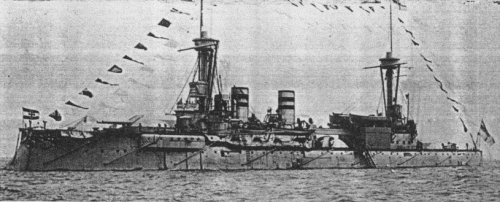

Kurfürst Friedrich Wilhelm 1905
| Name | No | Yard No | Builder | Laid down | Launched | Comp | Fate |
| Kurfürst Friedrich Wilhelm | 13 | Wilhelmshaven KW | 1890 | 30.6.1891 | 29.4.1894 | to Turkey 9.1910 (Barbaros Hayreddin) | |
| Brandenburg | 198 | Vulcan, Stettin | 1890 | 21.9.1891 | 19.11.1893 | barrack ship 1916 | |
| Weissenburg | 199 | Vulcan, Stettin | 1890 | 14.12.1891 | 14.10.1894 | to Turkey 9.1910 (Torgut Reis) | |
| Wörth | 52 | Germaniawerft, Kiel | 1890 | 6.8.1892 | 31.10.1893 | barrack ship 1915 |
|
Displacement normal, t |
10501 |
|
Displacement full, t |
10670 |
|
Length, m |
115.7 oa 113.9 wl |
|
Breadth, m |
19.5 |
|
Draught, m |
7.90 |
|
No of shafts |
2 |
|
Machinery |
2 VTE, 12 cylindrical boilers |
|
Power, h. p. |
10000 |
|
Max speed, kts |
16.5 |
|
Fuel, t |
coal 1050 + oil 110 |
|
Endurance, nm(kts) |
4300(10) |
|
Armour, mm |
Kurfürst Friedrich Wilhelm: belt: 400 - 180 (compound), deck: 60, cupolas: 120, barbettes: 300, battery: 42, CT: 300 Brandenburg: belt: 400 - 180, deck: 60, cupolas: 120, barbettes: 300 (A, B - compound, C - Krupp), battery: 42, CT: 300 Weissenburg: belt: 400 - 180 (compound), deck: 60, cupolas: 120, barbettes: 300 (A, C - compound, B - Krupp), battery: 42, CT: 300 Wörth: belt: 400 - 180, deck: 60, cupolas: 120, barbettes: 300, battery: 42, CT: 300 |
|
Armament |
2 x 2 - 283/37 MRK L/40 C/90, 1 x 2 - 283/32 MRK L/35 C/90, 6 x 1 - 105/32 SK L/35 C/91, 8 x 1 - 88/27 SK L/30 C/89, 12 x 1 - 7.9/80, 6 - 450 TT (2 bow, 4 beam) |
|
Complement |
568 |
Project history: The Brandenburg class were unusual amongst the pre-dreadnoughts of their era in having two different lengths of gun in their main armament. While the fore and aft turrets were 40 cal, the midship turret had 35 cal guns, to make them short enough to be trained round from one side to the other. This midships mounting proved unsatisfactory—the guns were too near the deck and caused blast damage when fired — and the secondary armament was weak by the standards of the time. However, the Germans were at last building sea-going battleships with a powerful main armament. An extra pair of 105mm guns were added later. These were the first German warships to be fitted with radio.
Ship protection, Kurfürst Friedrich Wilhelm: Mostly Krupp steel armour was used. Main belt (Compound iron-steel armour!) protected full hull length and had 400mm thickness amidships above CWL (backed by 200mm teak), tapered to 200mm below CWL on 400mm wooden backing; ship ends were protected by 300mm above CWL (backed by 300mm teak) tapered to 180mm below CWL backed by 420mm teak. Armoured deck had 60mm thickness. Barbettes were protected by 300mm armour backed by 210mm wood and were closed by 120mm cupolas with 50mm crowns. Battery had 42mm sides. CT had 300mm sides and 30mm roof.
Ship protection, Brandenburg: Mostly Krupp steel armour was used. Main belt protected full hull length and had 400mm thickness amidships above CWL (backed by 200mm teak), tapered to 200mm below CWL on 400mm wooden backing; ship ends were protected by 300mm above CWL (backed by 300mm teak) tapered to 180mm below CWL backed by 420mm teak. Armoured deck had 60mm thickness. Barbettes (A and B barbettes had compound armour, C barbette had Krupp steel) were protected by 300mm armour backed by 210mm wood and were closed by 120mm cupolas with 50mm crowns. Battery had 42mm sides. CT had 300mm sides and 30mm roof.
Ship protection, Weissenburg: Mostly Krupp steel armour was used. Main belt (Compound iron-steel armour!) protected full hull length and had 400mm thickness amidships above CWL (backed by 200mm teak), tapered to 200mm below CWL on 400mm wooden backing; ship ends were protected by 300mm above CWL (backed by 300mm teak) tapered to 180mm below CWL backed by 420mm teak. Armoured deck had 60mm thickness. Barbettes (A and C barbettes had compound armour, B barbette had Krupp steel) were protected by 300mm armour backed by 210mm wood and were closed by 120mm cupolas with 50mm crowns. Battery had 42mm sides. CT had 300mm sides and 30mm roof.
Ship protection, Wörth: Mostly Krupp steel armour was used. Main belt protected full hull length and had 400mm thickness amidships above CWL (backed by 200mm teak), tapered to 200mm below CWL on 400mm wooden backing; ship ends were protected by 300mm above CWL (backed by 300mm teak) tapered to 180mm below CWL backed by 420mm teak. Armoured deck had 60mm thickness. Barbettes were protected by 300mm armour backed by 210mm wood and were closed by 120mm cupolas with 50mm crowns. Battery had 42mm sides. CT had 300mm sides and 30mm roof.
Modernizations: 1903, Wörth; 1904, Brandenburg, Weissenburg; 1905, Kurfürst Friedrich Wilhelm: - 4 - 450 TT (2 bow, 2 beam); + 2 x 1 - 105/32 SK L/35 C/91, 1 - 450 TT (stern)
Naval service: In 1910 two of the class went to Turkey. The remaining pair were transferred to coastal defence in 1915, disarmed and used as accommodation ships in 1916, and discarded in 1919. A conversion of Brandenburg to a target ship was never completed.

Wörth 1890s

Wörth 1900s
© Ivan Gogin, 2014